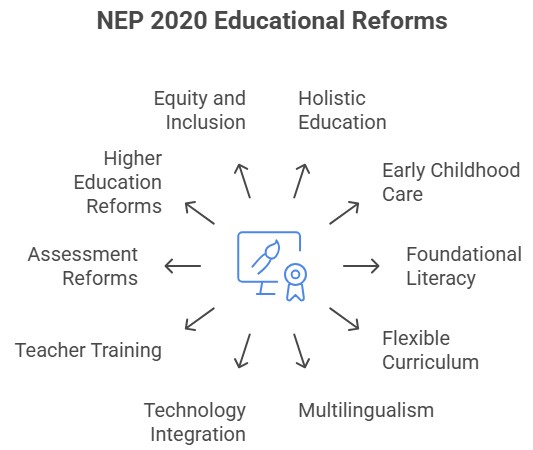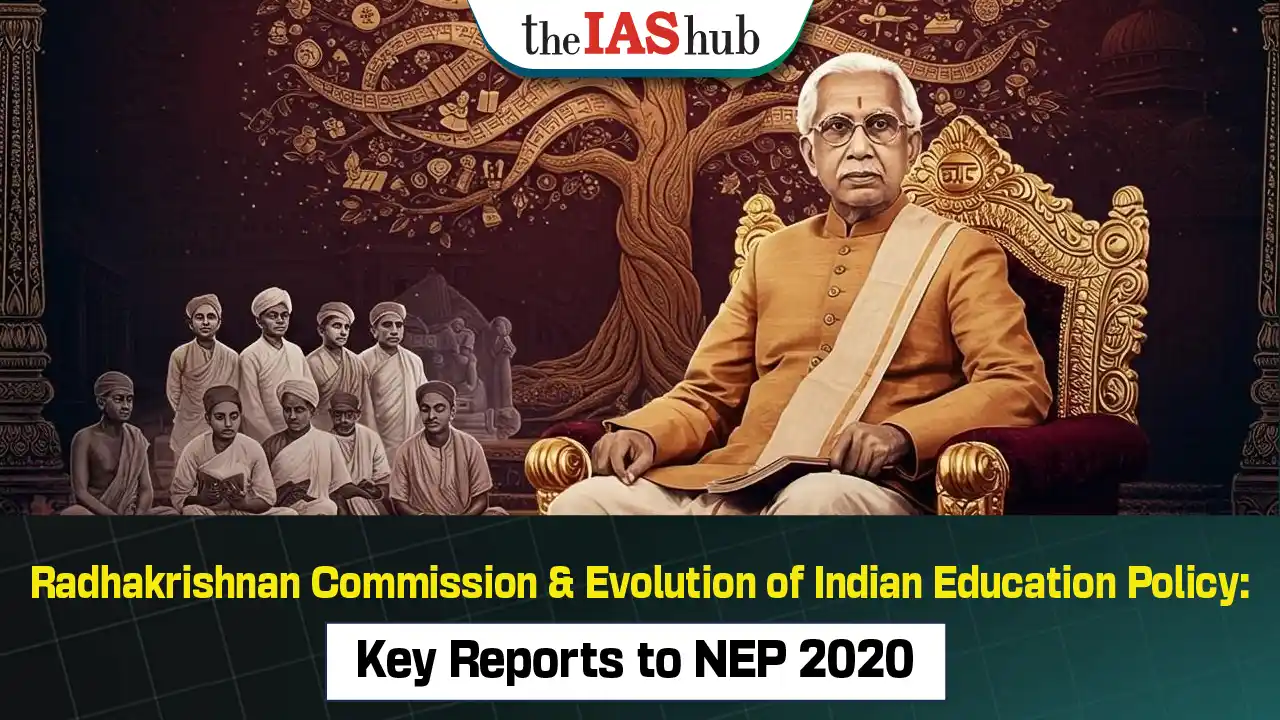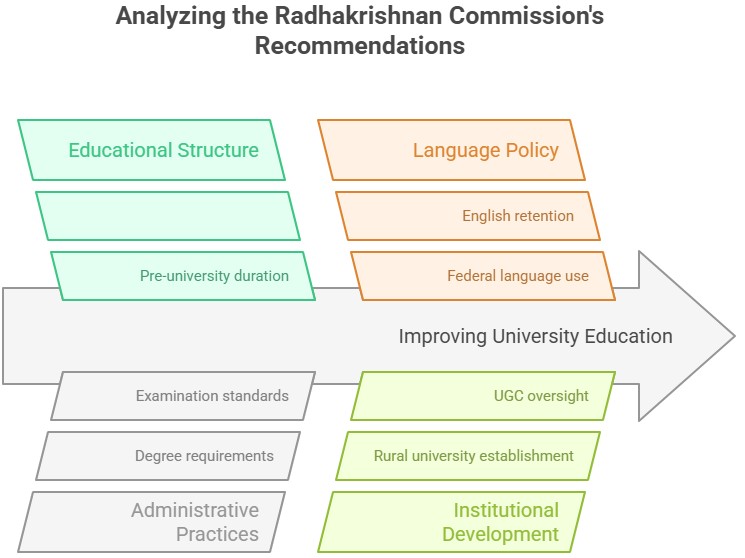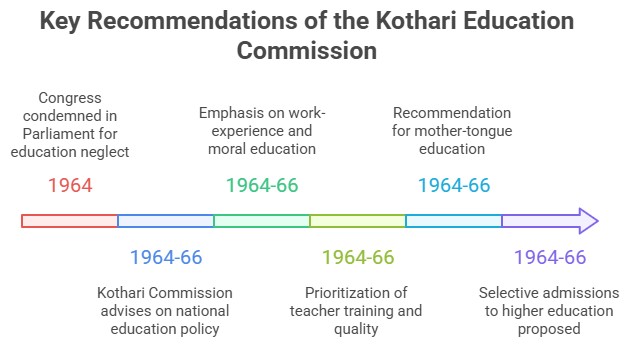Radhakrishnan Commission (1948–49) laid the foundation for reforms in university education in India, emphasizing quality, language policy, and administrative oversight. Subsequent commissions and policies, including the Kothari Commission and NEP 2020, have shaped the evolution of India’s education system toward inclusivity and modernization.
Radhakrishnan Commission 1948–49
The commission investigated university education throughout the nation. The main suggestions were these.
- Pre-university education should last 12 years.
- Central, liberal, and occupational education should comprise higher education.
- Administrative workers don't need degrees.
- Establish Shantiniketan and Jamia Millia-style rural universities.
- University education should be in the constitution's "Concurrent List" and examination requirements should be improved.
- A national University Grants Commission should oversee university education.
- Higher education should not abandon English.
- Where federal language and mother tongue are different, federal language should be the medium of education; where they are the same, the kid should learn a classical or modern Indian language.
Steps taken on Radhakrishnan Commission (1948–49)
- Following these recommendations, the University Grants Commission was established in 1953 and granted autonomous statutory status by an act of parliament in 1956.
Mudaliyar Commission for secondary education in 1952.
- No formal policy was created from these commissions' reports, but action was taken.
Kothari Education Commission (1964-66)
Congress was condemned in Parliament in 1964 for neglecting to promote a national education concept and vision. Thus, Dr. D.S. Kothari's commission advised on national education policy. The commission's findings highlighted:
- Work-experience, including manual labour, production, and social service, is included into general education at all levels.
- Moral education and social responsibility.
- Secondary school vocationalization.
- Strengthening advanced study centres and creating a few big universities with excellent international standards.
- Teacher training and quality are prioritised.
- Educational rebuilding should prioritise agriculture and allied science education and research.
- Quality or pace-setting institutions at all levels and sectors.
- The commission found that mother-tongue was best for school and college education.
- Additionally, school and higher education should use the same medium.
- Higher education should use regional languages.
- The panel also noted that demand for secondary and higher education had increased and would continue to rise.
- To meet public demand and existing facilities, selective admissions to higher secondary and university education were needed.
National Education Policy 1968
Indira's first National Policy on Education (NPE) followed Kothari Commission recommendations.
Policy highlights included
- Free, mandatory education till 14.
- Improved teacher status and pay.
- Three languages—mother tongue, Hindi, and English—and regional language development.
- Science and research education parity.
- 6% of GDP on education, training, and teacher quality.
- Cheap textbooks of higher quality.
- Agriculture/industry education development.
Analysis
- It was the first attempt to give Independent India's educational system direction, making it a significant milestone.
- Three-language formula was praised for national integration. The policy's recognition of central government education promotion was a promising start.
- Critics said: Political compromise characterised the three-language model. Despite the good intentions, it would burden pupils.
Education in Concurrent List
- Before 1976, state administrations delivered education at the district and taluka levels, with the central government just advising.
- Academics believed that education delivery systems were inefficient, hence the central and states should share responsibility for it.
- The 42nd Constitutional Amendment Act of 1976 included education on the Concurrent List.
National Policy on Education, 1986 (NPE)
It sought to create a national education system that provided high-quality education to all pupils, regardless of caste, creed, sex, religion, etc. Some of its goals were:
- Primary education for all.
- Help youngsters gain important skills by improving school quality.
- Secondary education: Improve education by teaching computer skills.
- Higher education should enable reflection on important social, economic, cultural, moral, and spiritual issues.
- Thus, education must empower women and enable minorities and underprivileged groups achieve social equality.
Acharya Ramamurti Committee
In 1992, the Acharya Ramamurti Committee created the 1986 policy's Action Plan.
- The NPE 1986 was updated to achieve universal enrolment and retention of children in schools and successful completion of education up to 14 years of age.
|
Key Features of Acharya Ramamurti Committee
- The "plus two stage" was recommended for all schools.
- Decentralised elementary education planning and control were also considered.
- Value education and understanding the country's cultural heritage were stressed.
- To boost individual and national production, it prioritised vocational education.
|
Achievements of NPE 1986
- NPE 1986 was a milestone in independent India's history.
- Secularism, socialism, and democracy were stressed for the country's population.
- Policy aimed to reduce urban-rural education disparity and improve women, SCs, and STs' education and vocational training.
- Policy was criticised for ignoring other factors affecting education, such as civil society activism, research, and societal changes.
|
Right to Education (86th Constitutional amendment Act)
- The Constitution's Directive Principles mandated free and compulsory education until age 14, but this was not followed.
- In 1993, the Supreme Court ruled in J.P. Unnikrishnan vs. the State of Andhra Pradesh, establishing the right to free education for children under 14 and providing a legal remedy for inadequate facilities.
- The United Front administration proposed a Constitution Amendment Bill in July 1997 to add Article 21 A to the Constitution, which was enacted in December 2002 as the 86th Constitution Amendment Act.
86th Amendment
- It introduced article 21A, which stipulates that “the state shall provide free and compulsory education to all children of the age of six to fourteen years in such manner as the state may, by law, determine”.
- It paved the way for Right to Education Bill 2005, 2008, and 2009.
- Right to Education Act (RTE), 2009 Article 21-A took effect on April 1, 2010.
New Education Policy (NEP) 2020
It transforms education in India with key changes:
- Holistic education: Integrated approach with arts, sports, and vocational skills.
- Early childhood care: Quality education for children aged 3-6.
- Foundational literacy: Focus on reading, writing, and math by Grade 3. It aims to ensure that every child attains basic reading, writing, and mathematical abilities early in their education.
- Flexible Curriculum and Choice-based Learning: Choice-based learning and multidisciplinary study options.
- Multilingualism: It encourages the medium of instruction to be the mother tongue or local language until at least Grade 5 and beyond.
- Technology integration: The policy emphasizes the integration of technology in education to enhance teaching and learning. It aims to provide digital infrastructure, e-resources, and platforms for online learning, especially in remote areas.
- Teacher Training and Professional Development: The NEP focuses on enhancing the quality of teachers through improved training, continuous professional development, and standardized teacher recruitment processes.
- Assessment Reforms: The policy advocates for a shift from rote learning to a competency-based assessment system. It promotes formative assessments, critical thinking, and analytical skills rather than relying solely on high-stakes board exams.
- Higher Education Reforms: The NEP introduces reforms in higher education, including the restructuring of the higher education regulatory system, the promotion of research and innovation, and the establishment of a National Research Foundation (NRF).
- Focus on Equity and Inclusion: The policy aims to address inequities in education access and quality by providing special provisions for disadvantaged groups, economically weaker sections, and students with disabilities.

Conclusion
India has evolved to a rights-based framework that requires the central and state governments to implement this essential child right as guaranteed in Article 21A of the Constitution in line with the RTE legislation.
Scientific Developments
After India's independence in 1947, the country has made significant scientific advancements across various fields. Here are some key scientific developments in India after independence:
Technical education, Space Research and Exploration: The government worked to improve technical education infrastructure.
- The government opened the Indian Institute of Technology (IIT) in Kharagpur, West Bengal, on August 18, 1951.
- It opened the nation's first technical college.
- In Bombay, Madras, Kanpur, and Delhi, similar institutions followed.
- The government produced the Scientific Policy Resolution of 1958, which emphasised "pure, applied, and educational" cultivation of science and scientific research.
- Establishment of DRDO: The government merged the Technical Development Establishment, Directorate of Technical Development and Production, and Defence Science Organisation to create the country's top military research and development organisation, the Defence Research and Development Organisation (DRDO).
- Space research: The government established the Indian National Committee for Space Research (INCOSPAR) under the Department of Atomic Energy (DAE) in 1962. Indian Space Research Organisation (ISRO) replaced it in 1969.
- Rohini, the first Indian satellite launched using SLV-3, was launched by ISRO in 1980.
- ISRO has successfully launched numerous satellites, including the Chandrayaan lunar missions and the Mars Orbiter Mission (MOM).
- Geosynchronous Satellite Launch Vehicle (GSLV): India developed the GSLV, a launch vehicle capable of placing satellites into geostationary orbits. It has played a crucial role in India's space exploration efforts.
- Mangalyaan (Mars Orbiter Mission): In 2014, India successfully launched the Mangalyaan spacecraft, making India the first country to reach Mars' orbit in its first attempt.
- Currently India is planning to study Sun (Adity L-1 Mission) and Under Gaganyaan Mission, it will send the first-time humans to the space.
|
India's first privately-developed rocket:
- Vikram-S, India's first privately-developed rocket, lifted off from Indian Space Research Organisation's (ISRO) launchpad in Sriharikota in November 2022.
|
Nuclear Technology
- Nuclear Power: India has made advancements in nuclear power generation.
- Nuclear Weapons Program: India conducted its first nuclear test in 1974 and became a nuclear weapons state in 1998. These developments marked significant milestones in India's nuclear technology capabilities.
Information Technology (IT) and Software
- IT Services and Outsourcing: India has emerged as a global leader in IT services and software development. Indian IT companies provide a range of services, including software development, IT consulting, and business process outsourcing.
- Software Development: Indian software developers have contributed to various sectors, including finance, healthcare, e-commerce, and telecommunications.
- Overall, India's tech industry is estimated to touch $245 billion in the 2022-23 financial year, with an incremental revenue addition of $19 billion during the same period
Biotechnology and Pharmaceuticals
- Pharmaceutical Industry: Indian pharmaceutical companies have made significant advancements in drug research and development.
- Biotechnology Research: India has made strides in biotechnology, including areas such as genetic engineering, bioinformatics, and biopharmaceuticals. Research institutions and biotech companies contribute to scientific breakthroughs and drug discovery.
- The Ministry of Science and Technology created a biotechnology department in 1986, which boosted development in that area. Biotechnology helped Indian agriculture.
Pharmaceutical Industry in India
- The pharmaceutical industry in India is expected to reach $65 Bn by 2024 and to $130 Bn by 2030.
- The pharmaceutical industry in India is currently valued at $50 Bn.
- India supplies over 50% of Africa’s requirement for generics, ~40% of generic demand in the US and ~25% of all medicine in the UK.
|
Renewable Energy and Environmental Technologies
- Solar Power: India has witnessed significant growth in solar power generation. It has implemented large-scale solar energy projects and initiatives to promote renewable energy adoption.
- Environmental Technologies: Indian scientists and engineers have developed technologies to address environmental challenges, including waste management, pollution control, and water conservation.
- India stands 4th globally in Renewable Energy Installed Capacity (including Large Hydro), 4th in Wind Power capacity & 4th in Solar Power capacity (as per REN21 Renewables 2022 Global Status Report).
|
Scientific Institutions and Research
- Premier Research Institutes: India is home to esteemed research institutions such as the Indian Institutes of Technology (IITs), Indian Institutes of Science Education and Research (IISERs), and Council of Scientific and Industrial Research (CSIR) labs. These institutions contribute to innovative research and innovation.
- DST was founded in 1971. It promoted and identified frontline and priority R&D in many science and technology fields, international scientific and technological affairs, and science and technology entrepreneurship.
- Science Education and Research Funding: The government has focused on promoting science education and research funding, providing support for scientific research and infrastructure development.
- The first Indian Antarctic mission left Goa in 1981, the "Indian Antarctic Programme" began. Indian Antarctic base Dakshin Gangotri received more missions each year.
- Maitri, a permanent Antarctic base constructed in 1991, is still in operation.
Institution of Eminence (IoE)
- In 2018, the government awarded Institution of Eminence (IoE) status to three public and three private institutions — IIT-Delhi, IIT-Bombay, Indian Institute of Science (IISc), BITS-Pilani, Manipal Academy of High Education, and Reliance Foundation’s proposed Jio Institute near Navi Mumbai.
- The Union Cabinet had approved UGC’s ‘Institutions of Eminence Deemed to be Universities Regulations 2017’, in August, 2017.
|
Conclusion
The scientific developments in India have contributed to national progress, technological innovation, and global recognition.














